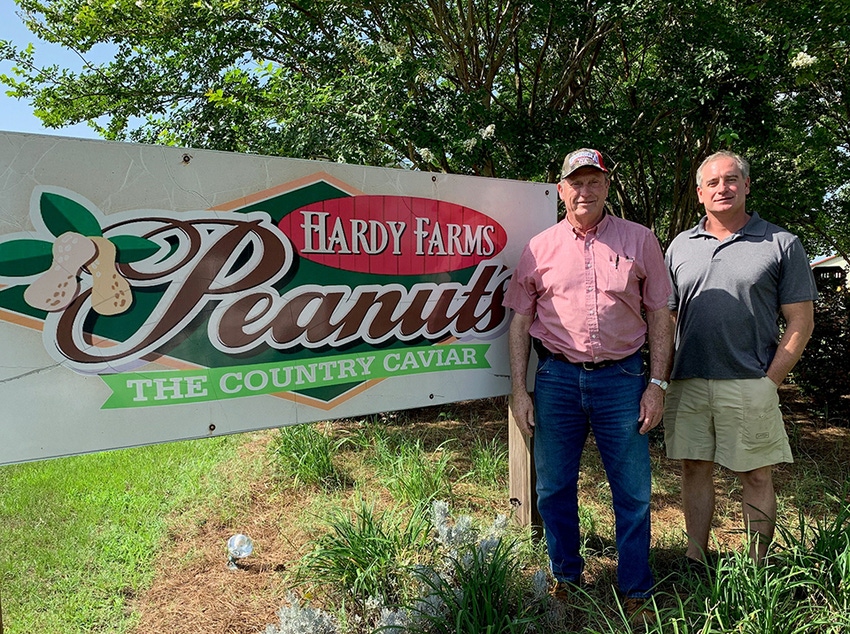
There are peanuts and then there are green peanuts.
Peanuts are harvested and dried, stored, shelled, blanched, typically roasted (or fried) and transformed into peanut butter, roasted nuts and a myriad of other delicious things.
Green peanuts are quite different, and it is this difference that makes all the difference. Green peanuts are highly perishable, harvested immediately after inversion, and refrigerated quickly. To learn more about growing a crop of green peanuts, I dropped in on Alex and Ken Hardy at Hardy Farms, a family-owned business in Pulaski County, Ga.
The Hardy family has long farmed peanuts, and since 1991 they have specialized in growing green peanuts for the fresh market. Hardy Farms is recognized as a leader in the innovation of producing and marketing boiled peanuts. Their enterprise employs 13 workers full-time and another 37 on a seasonal basis. They direct market boiled peanuts at 25 easily-recognizable roadside stands and their brand of boiled peanuts can be found in supermarkets such as Publix and Kroger. However, Alex tells me that 70% of their green peanuts are sold fresh (not boiled) to markets across the country.
Variety Matters
Peanut variety Georgia-06G has many strong attributes. The single largest reason it dominates the southeastern production today is its yield potential. However, according to the Hardys, yield is not the most important consideration for the green peanut market. For green peanuts, size is most important, bigger is better, and bright, clean pods are second in importance. Superficial discoloration and blemishes are of negligible importance to most of Georgia’s peanut producers, but anything that detracts from the brightness of the pod is important for the green market.
Although Georgia-06G is planted on the majority of the peanut acreage (and can make delicious boiled peanuts), the Hardys do not plant it for their green peanut markets. Today they grow three varieties: Virginia-type Wynne and runner-types Georgia-03L (for which they must save their own seed) and TUFRunner 297. The Hardys may be the only farmers in Georgia growing Wynne and Georgia-03L and are among a minority of growers planting 297. They preferentially grow these varieties because they better fit the requirements for great boiled peanuts.
Planting date can be different between peanuts and green peanuts. The majority of peanut grown in Georgia are planted between the last week of April and the first week of June, primarily to minimize risk to tomato spotted wilt disease. Green peanuts are planted as early as the end of March and well into June to take advantage of market opportunities and for sale of freshly-boiled peanuts.
In standard production, the hull-scrape method is used to determine optimum maturity at which time the peanuts are dug. Harvest is very different for green peanuts. Maturity is important, but green peanuts are typically dug two weeks earlier than the anticipated peak maturity as more-mature boiled peanuts become more difficult to remove intact from the shell.
After inversion, green peanuts are left just long enough (15-30 minutes) so that the soil clinging to the roots and pods will dry. They are quickly picked, washed, sorted and chilled, all within about an hour’s time.
Offsetting Disease
By necessity, the Hardy family doesn’t grow the most-disease resistant varieties or plant in the window of lowest risk to tomato spotted wilt disease and pod blemishes affect the value of their crop. Because of this, they have incorporated several production practices to offset these problems.
First, the Hardys typically use both Thimet and Velum Total at planting to manage thrips, tomato spotted wilt, seedling disease, and nematodes. They use Propulse fungicide/nematicide at pegging time to further fight nematodes. They ensure a seeding rate of six seed per foot and plant on twin rows to reduce risk to tomato spotted wilt. To further reduce damage from nematode and soilborne diseases, they deep-turn their fields.
For many, including my family, boiled peanuts are an integral part of the 4th of July. Few things evoke memories of happier, simpler times than do roadside stands selling boiled peanuts. A polite greeting, the smell of hot brine, the slow, deliberate ladling of the peanuts into a Styrofoam cup, and the salty dribble down my chin and on my hands are favorite images from summers of childhood.
Much of my “growing-up” was spent in small town Interlachen, Fla., where venturing to Palatka was a big deal. In that world, my sisters and I ate boiled peanuts, a treat so delicious that we knew everyone must love them. Growing older, I have learned that there are a surprising number of people who have never tried boiled peanuts, or, who, inexplicably, don’t like them.
I asked Ken Hardy about this and he agreed that, on occasion, they will meet those who say they don’t care for boiled peanuts. He notes that is often when the peanuts have been dry-stored before being boiled. “Those are not the same as a fresh, green peanut, which are sweeter. Once they have tried a green, boiled peanut, they almost always change their minds.”
“After all, boiled peanuts are ‘country caviar,’” Alex said.
About the Author(s)
You May Also Like






